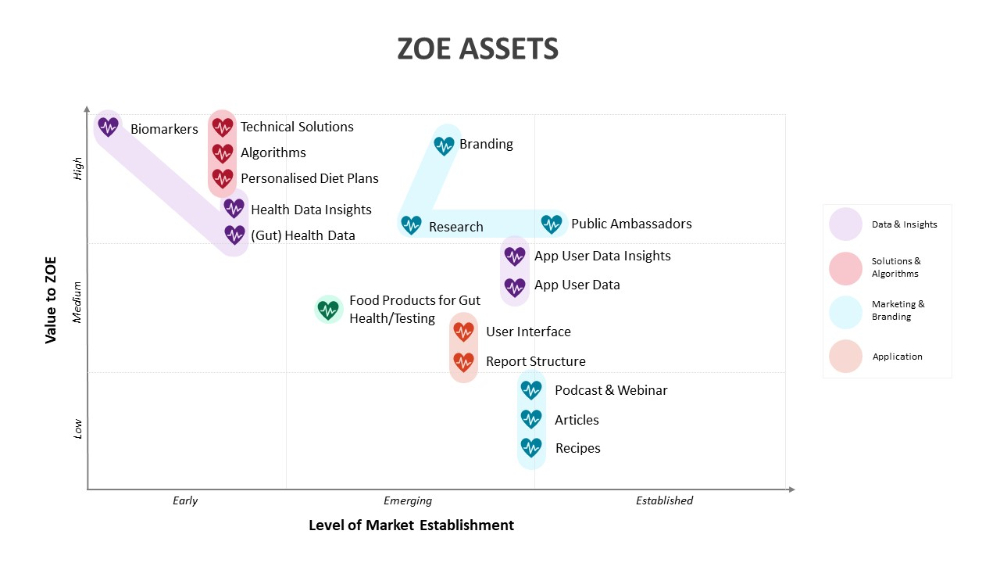Protect value by framing any consideration of the use of IP in the context of a business's competitive advantages
In this article, we show how to protect value by framing any consideration of the use of IP in the context of a business's competitive advantages. We do this using ZOE as an example of a well-known business, based on our own research from publicly available resources only.*
Introduction to ZOE
ZOE personalises nutrition by aligning your food choices with your unique biology. Unlike "one-size-fits-all" diets, ZOE leverages at-home tests to understand how you process food. Participants test their blood sugar, blood fat, and gut health using a continuous glucose monitor, a stool sample kit, and a finger prick blood test. They then log their diet for two weeks. This data generates a personalised report that scores foods based on their impact on your individual biology, helping you optimise your gut and metabolic health. An accompanying app provides ongoing guidance with personalised recipe recommendations. Since launching in April 2022, ZOE has analysed data from over 50,000 individuals and has grown an online community exceeding 2 million people. Users often report experiencing increased energy levels, better hunger control, and even weight loss.
In January 2024, ZOE expanded its marketing presence through a collaboration with Marks & Spencer to release the 'M&S Food x ZOE Gut Shot', a beverage combining ZOE's expertise in nutrition science with M&S's reputation for quality and innovation. To further empower individuals, a free gut health guide was included with every purchase.
What are ZOE's competitive advantages?
Using Simon Wardley's mapping technique, and based on our own public research, we have arranged what we believe to be ZOE's key intangible assets from the perspective of market establishment and value to ZOE. This provides a high level visual of ZOE's diverse range of intangible assets, and in doing so helps uncover what we believe to be its competitive advantages.

In our view, the key intangible assets which makes ZOE's product so successful are the insights it has derived from analysing its users' gut and health data and the technical solutions and techniques it has developed, such as personalised diet plans and improved methods for at-home testing.
We expect ZOE to build its future competitive advantage by using its wealth of microbiome data and insights to identify novel methods for measuring health statuses from gut health, as well as biomarkers that can be used for diagnosing diseases. These will be of high value to the field of medicine and health and would transform ZOE from a company that produces helpful personalised diet plans to one that could benefit the lives and wellbeing of many.
ZOE has also leveraged high-profile brand ambassadors to build initial brand awareness. As an asset, brand ambassadors are an established marketing technique and indeed many other individuals could be used by ZOE or its competitors to play a similar role. However, founder Professor Tim Spector is a highly visible and respected scientist and adds credibility and trust to ZOE's brand, acting as another key component to its competitive advantage.
The user-friendly interfaces by which ZOE users navigate the main application, and its digestible reports are crucial for user engagement, overall retention and are improved over time by users' activity data on the application. However, these assets provide less of a competitive advantage since competitors could build applications which perform similar functions and look similar (although crucially without ZOE branding).
ZOE's other marketing activities (podcasts, webinars, articles, and recipes) are important aids to enhance user experience and further brand awareness. Indeed, ZOE claims to have the no. 1 nutrition podcast in the UK, with over 3 million downloads. However, these marketing assets contribute less value to ZOE's long term competitive advantage because competitors could produce similar content with little effort.
How can ZOE build a moat around its competitive advantages?
To build a strong competitive moat, a business like ZOE should consider deploying a variety of IP, secrecy, and relationship-based control mechanisms.
Patents: We see the opportunity for ZOE to use patents to control technical solutions, such as novel methods to generate personalised diet plans and microbiome fingerprints. ZOE has already filed 28 patents (belonging to 8 families/inventions). By securing patents for their solutions, companies can maintain a competitive advantage through exclusivity. By keeping these assets low in market establishment with few, if any, alternative offerings, it will remain high in value. Patents can also act as a strong deterrence against infringement and could represent a separately licensable, revenue-generative asset. However, as the patent portfolio and the significant associated costs grow, it will be critical to have a detailed understanding of the market and competitive technologies to determine which deliver the most value. Too often businesses patent what is patentable, rather than what is valuable. And in most cases in a large patent portfolio, just a few patents/clusters of patents will have disproportionately high value. The challenge for businesses is to have the data and insight to determine which they are.
Copyright: Any original code that ZOE has developed for its applications will anyway automatically be protected by copyright, but from a value protection point of view is often better managed as a trade secret. Copyright (©) notices in the application interface or T&Cs are also good practice.
Trade Secrets: ZOE may want to consider controlling its most valuable algorithms and know-how by maintaining them as a trade secret, as part of internal code base, to prevent it from being replicated by competition. Those of highest value should be closely managed and disclosed internally only on a strictly need to know basis.
Trade Marks: Businesses, such as ZOE's, often trade mark key elements of their brand (names, logos, taglines etc) to safeguard brand identity and reputation from unauthorised use by others. Having trade marks can also be a significant asset to future business transactions, similar to ZOE's recent collaboration with M&S, and helps in building and maintaining a strong brand image and equity.
Actively pushing assets into the market: ZOE may consider continuing to actively disseminate its marketing assets, such as podcasts, recipes, and articles, to a wide audience free of charge, as well as publicly share some of its scientific insights. These insights should be sufficient to engage the audience and demonstrate the robustness of the science, without disclosing the most valuable information. Actively promoting these marketing assets and scientific insights will help build trust in ZOE's brand and develop a network effect by increasing audience engagement, making it more difficult for competitors to enter the market.
Relationships: Lastly, retention of influential brand ambassadors thorough strong contractual terms will ensure they continue to help enhance ZOE's brand in the long term.
Conclusions
Contextualising assets within the market and understanding their present and future value is crucial for informing a robust IP strategy. Simply protecting assets is not enough; companies like ZOE must also understand the "why" behind controlling them. This deeper understanding allows for strategic decision-making and maximises the value of those assets. ZOE's success in leveraging and controlling its most valuable intangible assets like user insights and technical solutions has enabled it to create a personalised and valuable offering that has propelled it to the forefront of the personalised nutrition market.
If you would like to identify the intellectual assets which underpin your business or build a control strategy to capture value and maintain competitive advantage, then please reach out to the Rouse Consultancy team.
The content of this article is intended to provide a general guide to the subject matter. Specialist advice should be sought about your specific circumstances.



